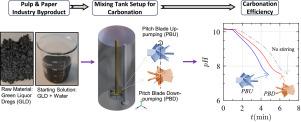The influence of the impeller on carbonation performances in carbon capture using industrial by-products
Q1 Chemical Engineering
引用次数: 0
Abstract
This study investigates the performances of radial flow (Rushton turbine and Parabolic) and axial flow (Pitch Blade Down-pumping [PBD] and Pitch Blade Up-pumping [PBU]) impellers in promoting CO2 capture via carbonation in various alkaline absorbents such as NaOH in ethanol, black liquor, and green liquor dregs. We performed experiments in a lab-scale reactor that show that the Rushton turbine exhibits superior effectiveness in industrial by-product-derived solutions such as 5% w/v aqueous green liquor dregs and black liquor, albeit at a high energy cost. However, in ethanol–NaOH mixtures, where the carbonation process inherently leads to an increase in viscosity, the PBD demonstrates superior efficiency. For example, in aqueous green liquor dregs at 400 rpm, down-pumping operation achieved pH = 8.5 with 13% improved performance at 25% w/v, whereas the up-pumping mode showed a 23% advantage at 5% w/v. In addition, power number reductions of up to 70% were observed with PBD compared to the Rushton impeller. Our main results are supported by numerical simulations that link impeller performances to mixing and vortical structures of the flow inside the reactor. The unique adaptability of the pitch blade, capable of mode-switching between down-pumping and up-pumping, offers distinct advantages through various stages of carbonation. The findings underscore the importance of analyzing the optimal impeller design for enhancing CO2 absorption efficiently, considering operational factors and the inherent variations in the process, especially in view of designing a large-scale reactor.

工业副产物碳捕集中叶轮对碳化性能的影响
本研究考察了径向流(Rushton turbine和抛物线型)和轴向流(俯仰叶片下泵[PBD]和俯仰叶片上泵[PBU])叶轮在不同碱性吸收剂(如乙醇、黑液和绿液渣中的NaOH)中通过碳化作用促进CO2捕集的性能。我们在实验室规模的反应器中进行了实验,表明拉什顿涡轮机在工业副产品衍生的解决方案中表现出卓越的效率,例如5% w/v的水绿液渣渣和黑液,尽管能源成本很高。然而,在乙醇-氢氧化钠混合物中,碳酸化过程固有地导致粘度增加,PBD表现出优越的效率。例如,在400 rpm的含水绿液渣中,当w/v为25%时,下泵操作的pH值为8.5,性能提高了13%,而当w/v为5%时,上泵操作的性能提高了23%。此外,与Rushton叶轮相比,PBD的功率数降低了70%。我们的主要结果得到了数值模拟的支持,这些数值模拟将叶轮的性能与反应器内流动的混合和螺旋结构联系起来。桨叶具有独特的适应性,能够在上下泵之间进行模式切换,在碳化的各个阶段都具有明显的优势。研究结果强调了分析叶轮优化设计对提高CO2吸收效率的重要性,考虑运行因素和过程中的内在变化,特别是考虑设计大型反应器。
本文章由计算机程序翻译,如有差异,请以英文原文为准。
求助全文
约1分钟内获得全文
求助全文
来源期刊

International Journal of Thermofluids
Engineering-Mechanical Engineering
CiteScore
10.10
自引率
0.00%
发文量
111
审稿时长
66 days
 求助内容:
求助内容: 应助结果提醒方式:
应助结果提醒方式:


